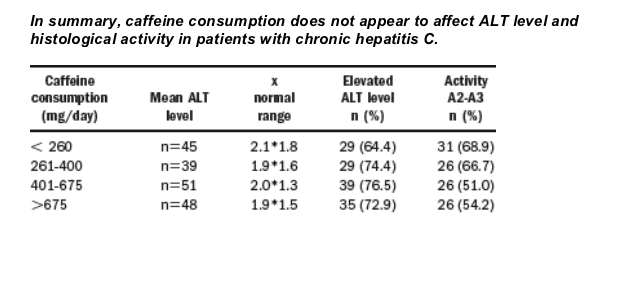 |
 |
 |
| |
IMPACT OF CAFFEINE CONSUMPTION ON ALT AND HISTOLOGICAL ACTIVITY IN PATIENTS WITH CHRONIC ACTIVE HCV
|
| |
| |
Reported by Jules Levin
http://www.natap.org
from AASLD
Nov 11, 2005, San Francisco
In summary, caffeine consumption does not appear to affect ALT level and histological activity in patients with chronic hepatitis C.
Charlotte Costentin, Department of Hepatology - Hopital Henri Mondor, Creteil, France; Christophe Hezode, Department of Hepatology - INSERM U635 - Hopital Henri Mondor, Creteil, France; Franc¸oise Roudot-Thoraval, Department of
Public Health - Hopital Henri Mondor, Creteil, France; Fatiha Medkour, Department of Hepatology, Creteil, France; Elie-Serge Zafrani, Department of Pathology -Hopital Henri Mondor, Creteil, France; Jean-Michel Pawlotsky, INSERM U635 - Department of Virology - Hopital Henri Mondor, Creteil, France; Daniel Dhumeaux, Department of Hepatology - Hopital Henri Mondor, Creteil, France; Ariane Mallat, Department of Hepatology - INSERM U581- Hopital
Henri Mondor, Creteil, France
It has recently been suggested that caffeine consumption is associated
to a lower risk of elevated serum alanine aminotransferase (ALT) activity in patients at high risk for liver disease (Ruhl et al. Gastroenterology 2005). This effect might be attributed to antioxydative properties of caffeine. Thus, the aim of this study was to evaluate the impact of caffeine consumption on ALT level and
histological activity in patients with chronic hepatitis C.
183 consecutive naıve patients with histologically proven chronic hepatitis C were included. Data collected included demographics, route of transmission, daily consumptions of alcohol, tobacco, caffeine during the 6 months preceding liver biopsy, body mass index, genotype, steatosis, activity and fibrosis (METAVIR) and ALT level at the time of liver biopsy.
Daily caffeine consumption was estimated as the sum of mean intakes of coffee, tea and caffeine-containing sodas. Patients (119 men, 64 women, mean
age: 44.6*10.9 years) were classified into 4 groups according to caffeine consumption.
The relationship between caffeine consumption, ALT level and
histological activity is shown below:
There was no relationship between daily caffeine consumption and ALT level or histological activity. Steatosis (OR 3.8 (1.6-9.2)) and elevated ALT (OR 3.3 (1.5-7.1)) level were the only two predictors of moderate-marked (A2-A3) activity by multivariate analysis.

|
|
| |
| |
|
 |
 |
|
|